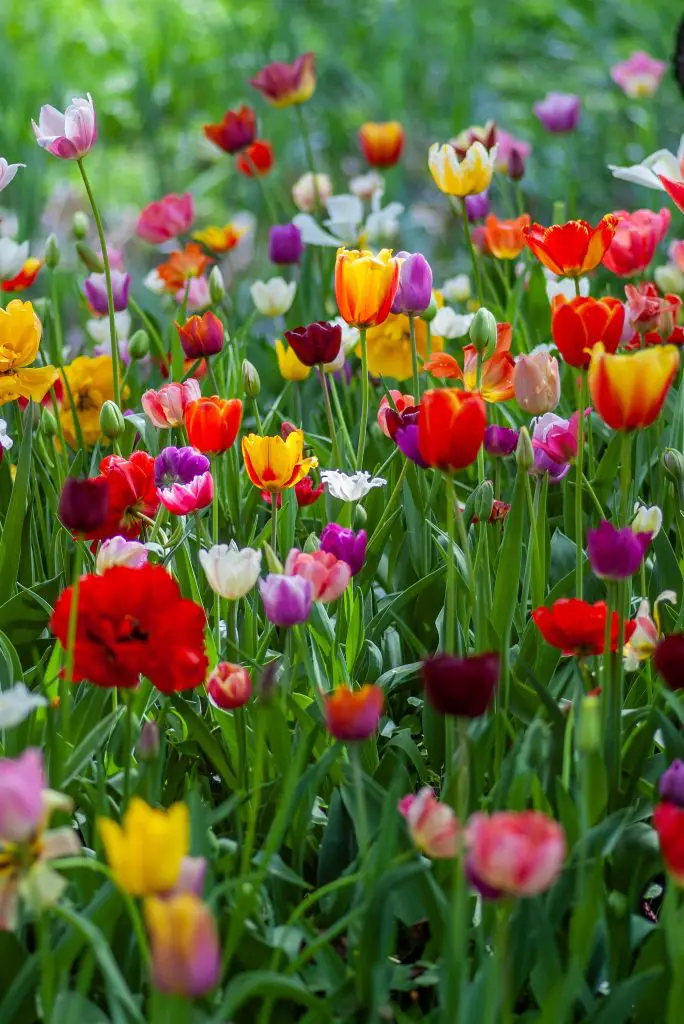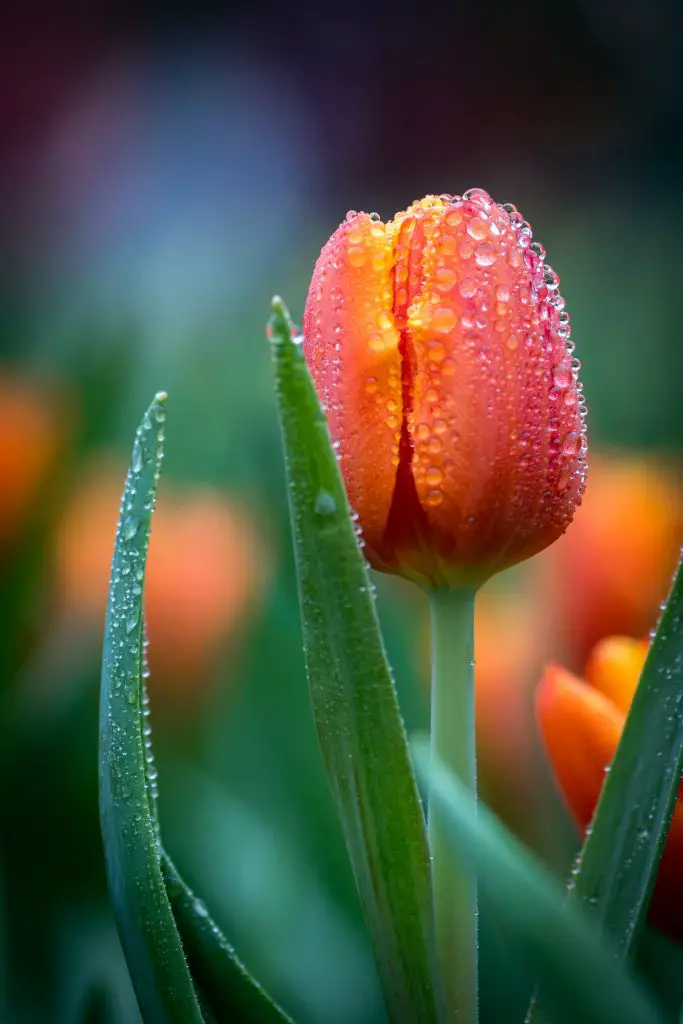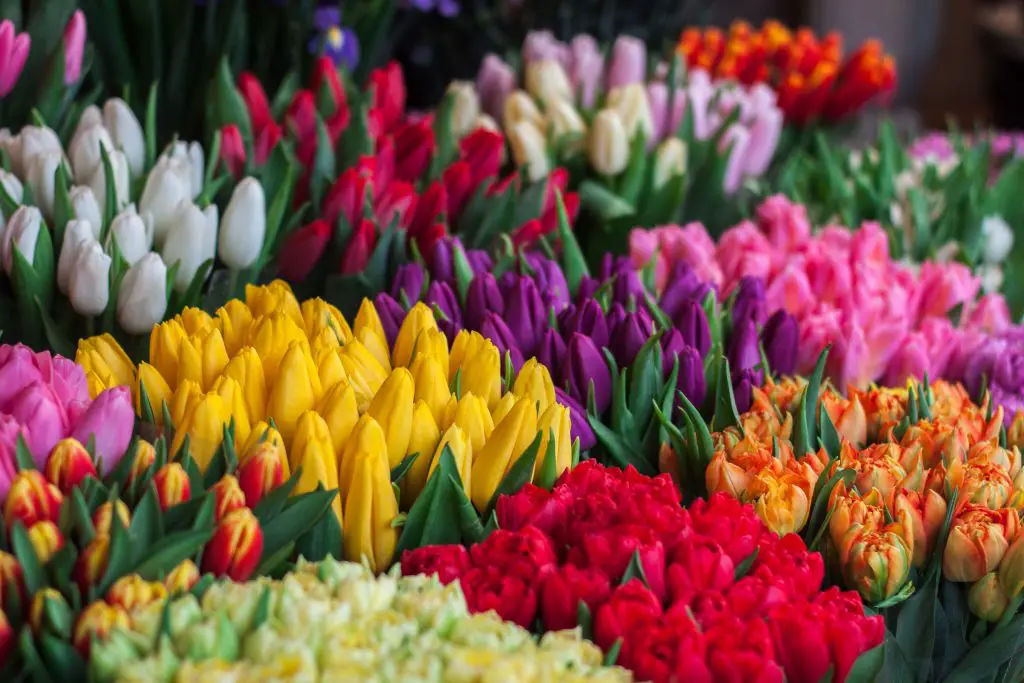Do tulips bloom more than once in the same season? Tulips are one of the most popular spring flower bulbs however, purchasing the bulbs can be expensive. So do they flower only once or is it possible to get them to bloom more than once in a single season?
Tulip bulbs only produce a single flower per bulb per season. The flowering period varies from early to late spring and only lasts a few weeks before they are gone. Unlike many other annuals and perennials, deadheading and removal of foliage does not encourage the production of another flower. However, the good news is that if you look after the bulbs they will reflower next year and there are things that you can do to extend the flowering period.
To extend the period of flowering early, mid-season, and late varieties of bulbs can be purchased that will flower from early spring to late spring. As there is a large number of varieties to choose from I highly recommend visiting gardenia.net as they have an excellent online resource with photos of each variety that will help you identify the perfect varieties for your garden.
In addition to selecting early, mid and late varieties the other trick that you can employ is to vary the conditions that the bulbs are stored in which will trick the bulb into flowering at slightly different times. To get the bulbs to flower over an extended period plant half in the ground and place the remainder in a paper bag in the fridge.
Wait until the shoots of the outdoor tulips emerge before planting out the bulbs from the fridge. These bulbs will start to shoot approximately 2 to 3 weeks after they are planted. This will extend the period over which you have tulips by a couple of weeks.

The other alternative is to bring the flowering period forward by growing them indoors in a vase. However, to do this successfully the tulips still requires a period of cold of at least 4 to 6 weeks which means that bulbs, purchased in Autumn, need to be placed in the fridge immediately and then removed a week or 2 before those that are being planted outside.
To ensure that the tulips look their absolute best inside it is important to select the right vase. Choose a vase that is around 6 to 8 inches tall to ensure that at least half the height of the flower stalks will sit above the top of the vase when it is flowering.
To prepare the vase thoroughly clean it to eradicate any germs. Make sure that all of the soap has been rinsed out of the vase. Place glass marbles at the base of the vase and then nestle bulbs into the marbles so that the roots fall in between them.
Fill the container with water until the roots are submerged in the water and leave the bulbs to grow. For the plant to grow successfully they will need to be exposed to light, however, avoid putting the vase on a window ceil that gets the direct afternoon sun. To see an example of this technique click here.
About Tulips
Tulips, sometimes know as Dutch Tulips are a member of the Liliaceae family of plants, and the genus Tulipa which comprises 110 distinct species including many hybrids and cultivars. Despite being associated with the Dutch the Tulips originated in Turkey and were cultivated in that region from around 1000AD onwards.
It was not until the late 16th century that the bulb were introduced into the Netherlands. The tulips progressively increased in popularity and price in the early 17th century. The increase in prices over time triggered a speculative frenzy between 1634 and 1637 which later became known as tulip mania.
During that 3 year period tulip bulbs reached the point where they were being treated as a form of currency and they were used to buy real estate and a range of other commodities. This abruptly stopped in 1637 leading to the first financial market crash in history.

The flowers themselves are available in nearly every hue except for a pure blue, and they can have ruffled or fringed flowers. The forms of the flowers are as diverse as the colors, with the goblet, cupped, bowl, and star-shaped varieties all being common. Tulip leaves are bluish-green, and depending on the variety they might be round, long and thin, or strap-shaped. The height of the tulip plants can vary from 6 inches to 2 feet tall.
As discussed earlier in the article Tulips are officially plants perennial, although, in practice, they behave more like annuals, with only one bloom every season. They are most suited to zones 3 to 8 where they can be left in the ground year-round. However, they can be grown in cooler and hotter climates if they are dug up at the end of each season.
In cooler locations the bulbs need to be removed from the ground to avoid the extreme cold, however, they also need to be removed from the ground in a warmer climate and stored in a fridge. The reason for this is that tulips require a period of cool to flower successfully.
How To Grow Tulips
Tulip bulbs should be planted in the fall, a few weeks before the last expected severe frost. However, if you live in a warmer location the bulbs should remain in the fridge for around 2 months before being planted out in mid-winter.
When planting the tulip in the garden choose a sunny spot that ideally receives 6 to 8 hrs of sun a day. The soil ideally should be rich, moist, and free draining. If the soil is too sandy it is advisable to add compost and 1 ounce of bone meal per square foot.
The Tulip bulbs should be planted in the ground with the pointy end facing up at a depth that is approximately three times the height of the bulb. The bulbs should be spaced approximately 4 inches apart in holes. The planting can be done with a spade however if you are planting a lot of bulbs you should consider investing in a bulb planter.
There are short-handled bulb planters that are relatively cheap and also long-handled versions that cost a little more but will save your back. The longer handle ones are also easier to use when the ground is relatively firm because you can use your foot to drive the bulb planter into the ground. Click on the links to see the latest price on Amazon.

Blooming Aftercare
Once the flower has started to die back the remaining petals may be removed however, the leaves of the tulip bulb should be allowed to die back naturally. The reason for this is that it allows the energy, accumulated by photosynthesis during the season, to return to the bulb for the following year’s blossom.
However, once the leaves turn brown the foliage may be removed by cutting it down to the ground. Tulips can be left in the ground if you are living in zone 3 to 8 provided that the ground does not get too wet during winter.
If you live in a region where it is necessary to lift the bulbs after flowering it is important to remove them carefully from the ground to avoid damaging them. Remove the excess dirt, and clean and dry the bulbs before storing them in a refrigerator for at least two months.
The reason why Tulips require a period of cold temperatures is that it stimulates the bulb to begin producing glucose. Glucose depresses the freezing point preventing the water from freezing solid and damaging the bulb. The release of glucose also serves as a source of energy for the plant’s foliage and flower development.
